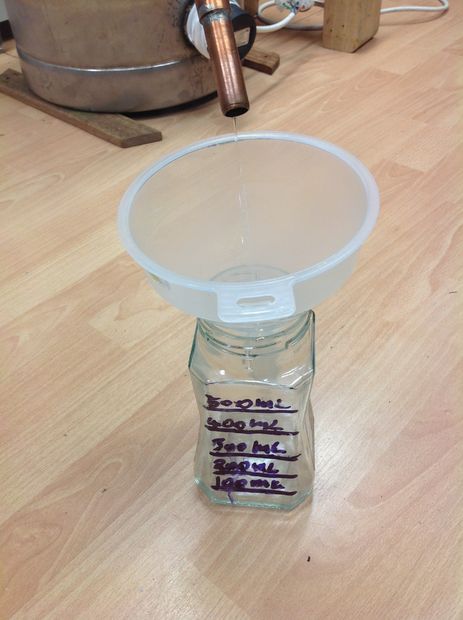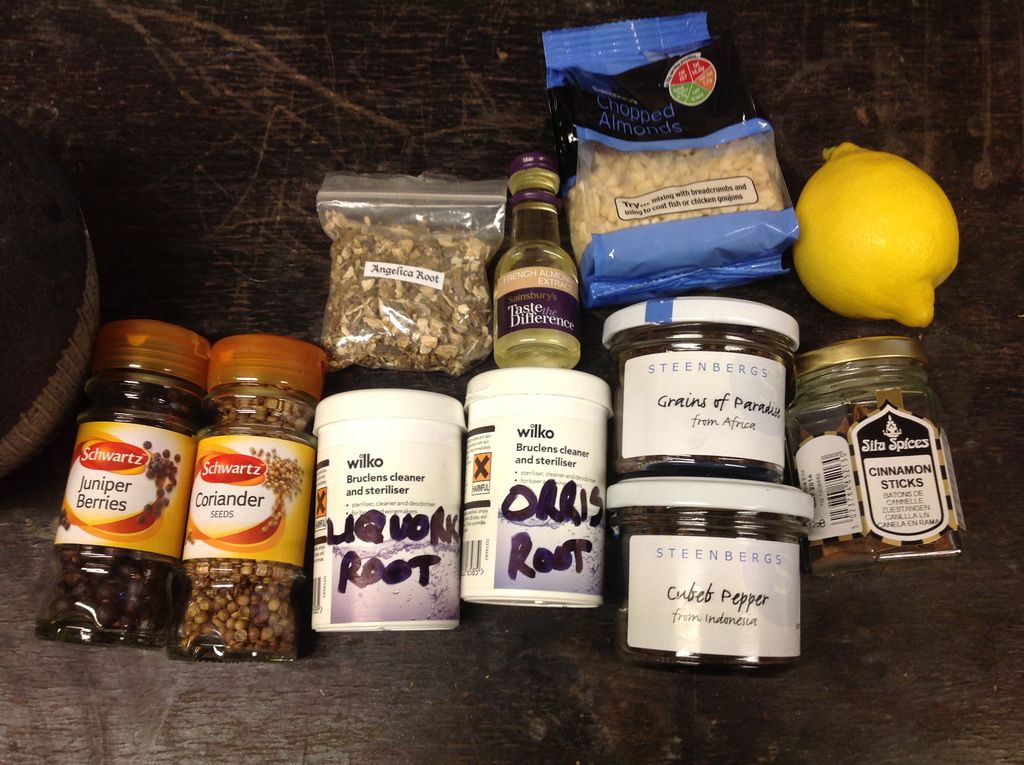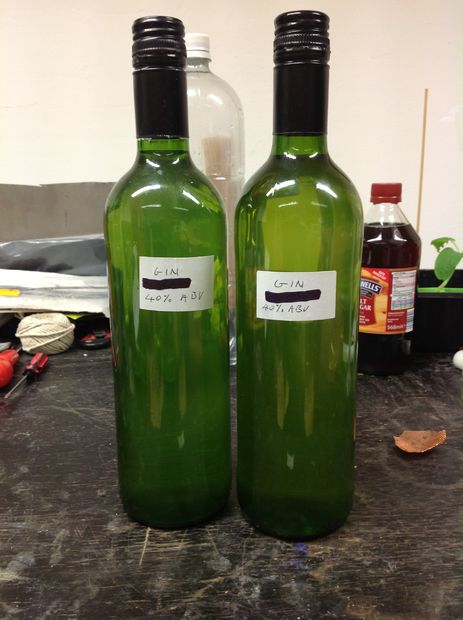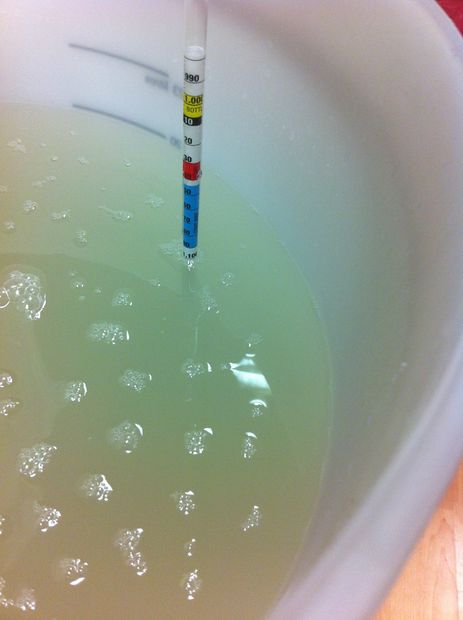Question ID: 4000-2453-0-1-2-5
Recipe Description
For this instructable you will need a Pot Still, here is my instructable on how to build one. https://www.instructables.com/id/Building-a-Keg-Still-Pot-still-design/ the other bits you will need are for the Spirit ------------------ 5 KG White Sugar 1 X Tube of tomato puree 1 X Lemon 50 g of baker’s yeast, You could use a couple of packets of baker’s yeast but it will take longer to ferment but the result will be the same. Clean water The Botanicals ---------------------- some of these might be tricky to get hold of, and some of them are very expensive. 20g Juniper Berries 10g Coriander Seeds 2g cubeb berries (this is an African pepper corn) 2g Grains of Paradise 2g Cassia Bark ( you could use a cinnamon stick but i would use much less of it if you do) 2g Powdered Liquorice root 2g Angelica root 2g Bitter Almond, now in the UK and US this is a listed poison due to the cyanide content, if you can get them you can use bitter peach kernels if not then you will have to do what I did and use a splash of Almond Extract but make sure it was made with bitter almonds. I also threw in some regular almonds for good measure. Lemon peel (get an unwaxed lemon if you can) 0.2g - 0.3g of orris root powder if you want to make Bombay Sapphire east then add the following as well 0.2g black pepper corns 0.2g lemon grass other equipment ----------------------- a tub for the botanical's to go in a pestle and mortar to mash the stuff up, you don't want to turn it in to powder so don't use an electric grinder, you could use a bag and a wine bottle if you are stuck. a Hydrometer that is for spirits a Wine Hydrometer a testing / ample tube a 25L Fermentation vessel with an air lock a long spoon scales some glass jars a glass demi john or a couple of 2 litre bottles to store the distillate in afterwards
first off we need to make up a sugar wash, to do this pour a couple of kettle loads of boiling water in to your sterilized fermenter. stir in all the sugar one bag at a time until all the sugar is dissolved. now top it up to around the 23L line with cold water. using a wine hydrometer it should have an SG (specific gravity) or around 1.100 Add in the juice of 1 lemon and the whole tube of tomato puree, stir this all in so there is not any lumps. when it has cooled down to about 23 degrees C sprinkle 50G of baker’s yeast on the top and stir in, you can you the little packets of baker’s yeast I would put at least 2 in but it may take longer to ferment. Pop the lid on the fermenter making sure you have an airlock on it. you need to try and keep it at about 23 degrees C so the yeast can live, the temp might be different if you are using a wine yeast so check the packet on its temps. if you have trouble keeping it warm enough you can pop a 50w aquarium heater in to maintain the temp. It should ferment out in about 7 days or more, you will know when its done when the bubbles stop coming from the airlock, at this point if you have an aquarium heater in it turn it off, and move it somewhere cool, ideally it should cool to between 10 and 15 degrees C. by cooling it the yeast should settle to the bottom which makes it easier to siphon it out. you should now have a wash with about 14% alcohol in it. NOTE: you may have a eggy smell from your ferment with some yeasts, don't panic it has not gone off, some yeasts just let of sulphur gases
We now need to put it through the still for the first time, this is called the striping run, what this does it to strip out all of the junk from the original ferment and reduces it down to a stronger alcohol. Using a wine or beer siphon you need to put the wash in to the boiler of your still, making sure you don't suck up the sediment at the bottom of the fermenter. if you have used a decent yeast you may want to keep the sediment for the next time you make a batch you can do this by putting it in a sterilized container and popping it in the fridge. turn the boiler on full power and wait for it to warm up until little drips start to come out of the output pipe, at this point turn on the water to the cooler and turn down your heater to about half the power. You will start to see a slow stream coming out of the output pipe within about 15 minutes so keep an eye on it. now this bit is very important, you need to collect about 100ml that first comes out of the still, this will contain all the bad stuff like methanol and acetone which we do not want as its very bad for you, throw this away or bottle it and use it as a cleaning product around your workshop. Whatever you do, do not drink this stuff it’s dangerous. Now just collect everything that comes out and put it in to a demi john or some 2 litre bottles, keep going until the distillate starts to come out cloudy, at this point you don't want to keep this stuff for your gin but you can bottle it up and put it in the still with the next time you do a first distillation and claim some of the alcohols back. if your using a spirit hydrometer you should see around 60% ABV coming out of the still doesn't matter if it’s a little less than that, and you should get between 2.5 and 3 litres of this percent. you will also notice if you are testing it as you go along that the ABV slowly drops as you go and then it starts to drop fairly quickly before its starts to become cloudy. when it gets to about 20% abv there's not much point in collecting any more as your just getting too much water so just turn off the boiler and wait a few minutes then turn off the water. wait for the boiler to cool down a bit and discard the contents down the drain.
this bit is easy enough, you just need to measure out the botanicals and crush them in the pestle and mortar to release the flavours and pop them in the pot you have put aside to hold them all in, you could just use a bowl and put cling film on it when you’re done. add 20g of juniper berries, because of their size it’s easier to crush them in batches, you just need to break them open you don’t need to turn them in to a puree or anything. add 10g of coriander seeds and crush them, this provides most of the citrus flavour so if you find this too strong in your gin just reduce this. add 2g cubeb berries, sometimes they call these cubeb pepper corns, crush these and add them to the mix. These will add much more floral aroma, including notes of lavendar and rose. add 2g of grains of paradise again crush them and add them to the mix, adds flavours from a strong peppery bite to light lavender notes add 2 g of Cassia Bark, or if using cinnamon use about 1g of a stick, crush it and add to the mix, you may notice that my jar says cinnamon sticks, it’s not its cassia bark I can see that it is but a lot of places call them cinnamon sticks because it releases a cinnamon flavour. add 2g of Liquorice root powder directly in to the mix add 2g of angelica root and grind this up in the pestle and mortar, this is hard work so just do it for as long as you can be bothered lol. add 0.2g - 0.3g of orris powder, I used some jewellers scales for this but you can see the amount in the cup I used, it is a small amount but it’s important as it binds the flavours together and has adds floral flavours. now your suppose to add 0.2g of lemon rind but I can never be bothered to weigh it out so I have been using unwaxed lemons and just using about half of the surface of it, you can see the amount in the pictures. now this is the bit where I had to get creative, you need Bitter Almonds, in the US and the UK these are listed substance and very hard to get hold of, you could use Bitter Peach Kernels but again some country’s including the UK have these as a listed substance as well. why are both of these listed substances? because they contain cyanide, in our process the cyanide would be destroyed by the heat in the still. but I couldn’t get either of those so I just added some Almond extract which came from bitter almonds and for good measure I threw in some regular almonds as well. Just mix this lot together then pop the lid on and get on with preparing your still.
With the second fermation you can’t just put the previously distilled spirit directly in the boiler and fire it up, this is dangerous, so what we need to do is make sure there is enough water in the still before we add the vodka/spirit. Fill it up so it’s over the element then wait a little more so there is a little bit of depth above the element. now pour in your spirit and the tails (the end part of a run) from any previous runs of gin or vodka, don’t use the tails from anything else as it could taint the flavour. this is the point where I had to improvise, most distillers make a basket for their botanicals which just slides up in to the column and I was no different, I made a basket up using copper mesh and a piece of pipe. However when it came to putting the basket in it wouldn’t fit because of a slight indent at the bottom where the easy flange was formed. as a quick idea I cut a piece of copper mesh that would fit in the column and push the middle in to create a dent so it would sit in the middle of the column. I spooned the botanicals in, gave the side of the column a couple of taps to get the loose bits to fall, then popped in a couple of stainless steel scrubbers in behind it. I had cleaned the scrubbers before this by pouring boiling water over them to remove any oils. using a dowel I pushed down the scrubbers until they stopped sliding, you don’t need to pack them down hard as you want the vapours to get through the botanicals. Pop the column on with a decent gasket and clamped it down using the tri clamp, making sure it was nice and tight, I use a screw driver to make it tight, put the cooler on and make sure its full of water, it doesn’t have to be running at this point. turn the boiler on full power, it will take about an hour to an hour and a half to heat up and the vapour works its way through the column. as soon as you see small drips coming off the output column cut the power to the heater by half and turn on the water for the cooler. you can collect the distillate from the start here, no need to discard the first part as all the bad stuff has been removed on the first distillation. It should be coming off at around 55% or a little more, collect it using the jars at 100ml at a time keep checking the alcohol volume and you will see it slowly getting less and less. Keep checking the colour of the distillate as well, it should always be clear. When the volume starts to drop faster keep an eye on what comes out as soon as you have any signs of it being cloudy stop adding it to the main batch. Keep collecting it though and bottle it separately, you can use this in the next run.
Bottling it up, to make it the strength of a proper gin it should be about 40% or 42% if your are making a Bombay Sapphire East style. so you need to water it down, to do this you need to use clean water, not tap water, you can use bottled water or distil water using your still. you can use this calculator work out what amounts you need to add to make up the target amount. http://homedistiller.org/calcs/dilute something I have noticed is that even though both the water and the gin are clear when you add them together for some reason it goes cloudy, not sure why it does this but it does not affect the taste. Don’t forget to label your bottles so you know how much alcohol is in it. Te feed back that I have had from people who have tried it, is that its not far off Bombay Sapphire, and often they have asked me for more ;-)
Question & Answer
Question: What is the correct order of the images?
Choices:
    |
| (A) |
    |
| (B) |
    |
| (C) |
    |
| (D) |
    |
|---|
 (D) (D) |